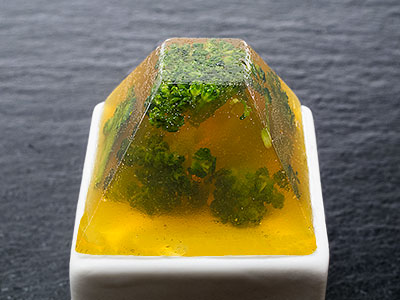November 26, 2012
Amuse-Bouche

soupe aux brocolis
(broccoli soup)
I do not like broccoli and I haven’t liked it since I was a little kid and my mother made me eat it. And I’m President of the United States and I’m not going to eat any more broccoli.
When George H. W. Bush made his now-famous pronouncement at a news conference on March 22nd, 1990, broccoli farmers were up in arms, but I think there were lots a folks quietly agreeing with him.
Much of my childhood dining was spent avoiding an interaction with broccoli. Like most vegetables, my mother never met a head of broccoli she couldn’t overcook. Overcooked broccoli is an abomination.
Then sometime in the 1980s, broccoli-cheese soup seemed to become omnipresent at corporate-run restaurants which, as a business traveller, I was frequently in more often than I wanted. The dish may have been preceded by broccoli-cheese casserole, for which Better Homes and Gardens had a recipe for in 1971. I can’t find the actual recipe but from the description it sounds like cooked broccoli with cheese soup poured over it, as a sauce, before baking.
For me, broccoli-cheese soup made broccoli palatable. Then I learned numerous Chinese methods of cooking broccoli, and I was hooked. By the time of Bush’s pronouncement, I was no longer in his camp.
My wife likes broccoli and buys it for her lunches. Unfortunately, she buys more than she can eat in a week, and it is left up to me to incorporate the remainder in one of our nightly meals. That was the case when I started working on my version of broccoli soup. That week there was enough left over for about 50 portions of my broccoli soup, so most was blanched and added to a green salad, and only a little was reserved for the broccoli soup.
Also at the same time, I had another leftover to contend with. A couple of days earlier, I was helping to teach a private cooking lesson for twenty people from one of the large nearby corporations. One of the recipes called for boneless chicken breasts, and the cooking-school buyer had purchased bone-in half breasts. So I brought home the scrap, half-breast carcasses with their pectoral minor muscles—the poorly labeled tenderloin—still attached. I threw these in a pot along with an onion, a carrot, and a few peppercorns. The solids were covered with cold water and placed over heat. The water was only brought to a simmer. It was never allowed to boil. After an hour, the broth was strained and agar was added at a level of 0.2% by weight. The broth was cooled overnight and the fat that had congealed on the surface was scraped off. The now jelly-like soup was mixed with a couple of egg whites and a half of a head of green cabbage cut into fine shreds. This mixture was brought to a boil, and the broth was clarified. The clear broth was passed though a piece of muslin, seasoned with salt, and set to cool in a flat pan. After cooling, the broth set into a firm gel.
For this broccoli soup I was only using the small buds at the very tip of the flowerets. Each tiny bunch of five or so buds were cut from their attachment with a pair of dissecting scissors. I needed five nice bunches for each portion of soup.
I had selected a silicone mold with fifteen pyramid-shaped cavities to finish the soup in, but first I had to cook the broccoli. To do this, brought the broth back to a high enough temperature to thoroughly melt the agar, but not hot enough to boil the soup. The broccoli was blanched in the hot broth until cooked, but still a bit crunchy. Even though the broccoli was removed from the broth, it was keep slightly warm so it would not start to gel. Fifteen nice specimens were placed in the apexes of the mold cavities so their stems pointed upward. This was followed by spooning just enough broth into each cavity to stabilize the broccoli piece but not enough to float it. When this first application of broth had started to gel. Four more blanched broccoli pieces were added to each mold cavity. Each was aligned so the buds sat against the flat surface of the mold cavity, and then a little more hot broth was drizzled over these newest additions to the mold. Once the most recent addition of broth started to gel, the mold cavities were filled with broth until it was level with the cavity openings. Because of surface tension, the broth needed to be coaxed into the corners of the mold. The filled mold was then refrigerated until the broccoli soup was thoroughly gelled.
The broccoli-soup pyramids came out of the molds easily, and I just stacked them in a single layer on a flat plate until each was needed. I was surprised that the pyramids didn’t exhibit any syneresis, even after a few weeks.
To serve the pyramids, I just placed them in 60 °C (140 °F) water for 7 minutes to reheat the soup. They didn’t need to be wrapped in anything while reheating, but it was necessary to drain them briefly on absorbent paper. It was imperative to get the warm broccoli soup out to my guests before it cooled.
© 2012 Peter Hertzmann. All rights reserved.
